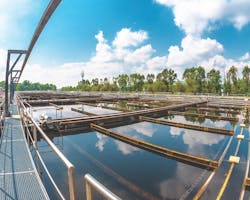About the author:
Jerry Berger is senior member of technical staff for Electro-Chemical Devices. Berger can be reached at [email protected].
The accurate process measurement of free chlorine, total chlorine and chlorine dioxide is essential to the successful operation of municipal and industrial water treatment systems that rely on this chemical for water disinfectant purposes, bleaching, corrosion prevention and other functions. Chlorine helps eliminate algae, bacteria, viruses, scale and other contamination in the treatment of both municipal drinking water and wastewater.
One of the most important things that all municipal and industrial systems have in common is their reliance on liquid analyzers to assure the maintenance of proper chlorine levels. Accurate, reliable analytical process measurement ensures public safety, protects plant equipment, increases quality, reduces maintenance, extends plant equipment life and lowers total costs.
Municipal Water & Wastewater
The majority of U.S. municipal water treatment systems disinfect their water using some type of chlorine-based process, either alone or in combination with other disinfectants.
Common pathogens including E. coli are controlled with chlorination, but failing to monitor or consistently maintain chlorine levels can result in less than appropriate disinfection levels and lead to disease outbreaks with devastating public health consequences.
Industrial Processes & Plants
Chlorine is also a common industrial bleaching agent in paper production and disinfectant in food and beverage plants, as well as providing oxidation control in chemical processing and other industrial operations including pharmaceuticals and textiles. The measurement of chlorine is important both in assuring the quality of water for cooling towers at petrochemical refineries and electric power generation plants to remove microorganisms, algae and biofilm in cooling water.
What is Free Chlorine?
Chlorine gas and/or sodium hypochlorite (bleach) are the common sources of chlorine in water. Both types form the same compounds when introduced to water: hypochlorous acid, HOCl, and hypochlorite, CIO—. The percentage of each component in solution is dictated by the pH of the solution. At roughly a pH level of 7.5, the ratio is 1:1. If the pH drops to 6.5, then the acid form is favored with 90% HOCl and 10% CIO—. At a pH level of 8.5, the alkaline form predominates as 90% CIO— and 10% HOCl.
Hypochlorous acid has roughly 10 times the oxidizing power of hypochlorite. These two types of chlorine are referred to as free chlorine. Other chlorine compounds may be present in the treated water as well, with organically bound chlorine and chloramine being the most common. These compounds are referred to as combined chlorine.
What is Total Chlorine?
Total chlorine is the sum of free chlorine and combined chlorine. The “combined chlorine” is typically referred to as what is “used-up” or “left-over” after disinfection. This residual amount is what is usually attributed as the cause for that bad smell in poorly treated pool water, which also can result in red eyes and burning skin. High total chlorine levels are an indicator that the water treatment disinfection system needs more free chlorine to do its job.
What is Chlorine Dioxide?
Chlorine dioxide (ClO2) is a chemical compound consisting of one chlorine atom and two oxygen atoms. It is a gas at room temperature that dissolves in water. It is used for a variety of antimicrobial uses, including drinking water disinfection, bleaching of paper and foods, corrosion control and sterilization. The U.S. EPA regulates the maximum concentration of chlorine dioxide in drinking water to be no greater than 0.8 parts per million (ppm).
Why & How is Chlorine Measured?
Chlorine is used primarily as a disinfectant or oxidizer or sanitizer; and, for best results, the levels must be monitored online, typically with a chlorine sensor. The chlorine is consumed as it disinfects, which is referred to as chlorine demand. To maintain the disinfection, a residual is needed. As such, the dose minus the demand equals the residual.
Free residual chlorine must be measured and controlled because it is an important aspect of keeping maintenance costs in line. The key to successful use of chlorine is in maintaining the right concentration. A chlorine concentration that is too high injects unnecessary costs into a process. Overly low levels of chlorine mean the process is not accomplishing the disinfection or other process goal and the process is ineffective.
Feedback in real time is critical with regard to how closely a process is maintaining the optimum levels of chlorination that are required. Concentration control of free chlorine at optimum levels means effective dosing occurs with no spikes or valleys that result when manual testing is performed. Additional benefits of online chlorine monitoring include:
- Lower chlorine usage. It is an expensive chemical to source given the amount of energy required to produce chlorine;
- Reduced maintenance needs by ensuring the process adheres to best practices; and
- Good environmental stewardship.
Process and plant engineers need free chlorine analyzer systems that measure precisely and are cost effective to install and maintain. The two major types of instruments for the measurement of free chlorine are colorimetric tests and amperometric analyzers.
There are two types of colorimetric tests. The manual test method is similar to a swimming pool test. The automated colorimetric test requires a sample system and reagents. Colorimetric tests are EPA approved for reporting purposes, but they are not real time measurements that are the best suited for accurate process control.
Amperometric analyzers feature a rugged chlorine sensor that is automatically compensated for pH. There are also multiple manufacturers of amperometric analyzers with many different models, as well.
What Measurement Challenges Exist for Different Applications?
Municipal Drinking Water. Drinking water comes from many sources such as lakes, rivers and groundwater wells. This water is dosed with chlorine in primary disinfection. It then is filtered and chlorinated again in the secondary disinfection step.
A chlorine residual is maintained in each of these chlorination steps. The secondary disinfection ensures disinfection of the water and provides a chlorine residual intended to maintain the sanitized water throughout the distribution system.
Process & Plant Cooling Towers. In the refining of oil and gas products and in specialty chemicals, the raw crude is typically heated at high temperatures in the separation process. In power plants, steam is generated to drive generators and in both cases large heat exchangers are cooled with water via cooling towers. Various chemicals, including free chlorine, are introduced into the water to prevent the growth of algae and biofilm that are a continuous maintenance problem.
Food Processing & Pasteurization Lines. Chlorine is commonly used as the sanitizing agent for rinsing fruits and vegetables before processing. It also is used in the rinse water at poultry and meat processing plants. Maintaining the proper chlorine residual in the recirculation tanks optimizes sanitizing power of rinse water and minimizes possibility of contamination, thereby conserving water.
Canned and bottled foods typically are pasteurized by passing through a hot water rinse or bath at the end of the packaging process. Recirculated water quickly accumulates products from the canning or bottling process, so a chlorine residual is maintained to sanitize this nutrient rich broth.
The Solutions
The Electro-Chemical Devices FC80, TC80, CD80 and CA6 chlorine analyzers are designed to measure free chlorine, total chlorine and chlorine dioxide (respectively) in wide range of municipal and industrial water treatment applications. These chlorine analyzers are designed to monitor chlorine in drinking water, rinse water, cooling water and other freshwater samples from 0.05 to 20 ppm Cl2, 5 to 9 pH , at temperatures from 32 to 122°F, and sample flow rates between 38 to 300 liters per hour (10 to 80 gallons per hour).
These are panel mounted systems and use a built-in constant head flow controller to optimize the flow past the chlorine sensor. The flow controller, chlorine sensor, pH sensor, and analyzer and controller are mounted on a PVC panel. Installation is complete after connecting the sample and drain lines, power and outputs. The low-maintenance FC80 and CD80 can run for up to one year between electrolyte and membrane changes.
Conclusions
No matter which type of sensor or system is chosen, the first requirement is accuracy and reliability of operation. The next criteria to consider are ease of installation and then maintenance requirements, which include the cost of reagents, replacement sensors and field technician time. The total installed costs and life cycle costs of any new chlorine or other parameter analyzer system also are critical aspects to consider.

